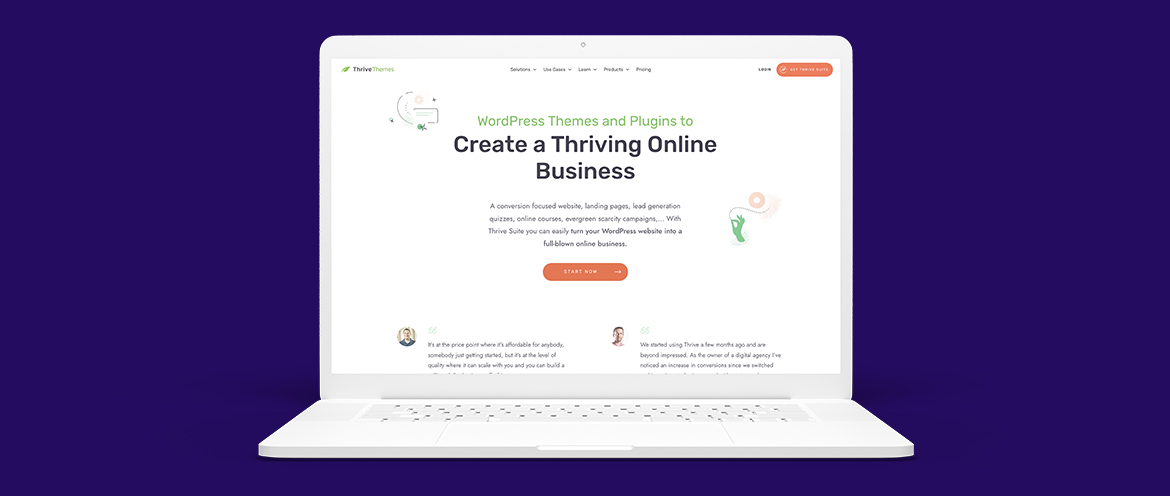There’s nothing more disappointing as an organization than seeing your marketing efforts fall flat every month.
Well, maybe it’s when your marketing manager drops their two week notice on your desk a month out from the big trade show.
The bottom line?
Marketing matters.
And, you’re probably investing a fair bit of time and money into it.
But, when it doesn’t work like you need it to?
It can feel like you’re banging your head against the wall, trying to eke out results that seem to come easy to your competition.
Let’s break down exactly what is causing this scenario (and what you can do to remedy it).

Marketing in the construction and energy space: an opportunity in the chaos
Think back to the day you really started wanting to see results from your digital marketing efforts.
If your company is like most construction or energy businesses, it was probably somewhere between 2014-2019.
And then when COVID hit, it became an un-questionable must for every business out there.
Including your competition.
But, here’s the thing: your marketing system was probably never built properly to support the results you wanted.
Every time you hire another marketer, put another dollar into paid ads, or publish another print spread, your efforts are being undermined by a lack of strategy.
You chase SEO, content marketing, trade publications, trade shows, social media, website optimizations, email marketing, and even billboards.
But, there is no underlying strategy.
No way to make sure what you’re doing is actually supporting an overarching direction for your business, and more importantly, your brand.
The good news?
Your competition is by–and–large in the same boat.
Thousands of companies vying for the same market, taking similar shotgun approaches to deploying their marketing (without a system to guide it).
Imagine what happens when you start strategically deploying a marketing system designed to put your brand on the map (exactly where you want it to land in front of your ideal clients).
Your marketing team is doing what they think you expect of them
Let’s say you have a marketing manager, Janice, and two marketing coordinators, Lee and Sarah, who have been in the industry for a handful of years.
Janice sets up a strategy every quarter.
“For Q3, I want to allocate a third of our budget into trade shows x, y, and z, because we met 25 engaged leads there last year, which drove $x of revenue.
“And then we really need to catch up on SEO and drive more organic traffic to the site, and I think a modest allocation in trade publications should get us a few phone calls.
“We’ll get Lee doing some keyword research and drafting 3-4 SEO articles per month, and Sarah and I will work on the trade show prep. We’ll design a half-page ad for ABC Magazine, because we can get a good deal there.”
But, what is she really saying here? What is going to be accomplished?
These are all channel strategies.
They absolutely have a direct impact on the bottom line, but why is the entirety of your marketing strategy “how much budget to deploy across which channels?”
The short answer?
That’s what you’ve come to expect from the marketing team, and they work hard to meet your expectations.
And quite frankly, you’re not giving them what they need to actually move the needle long-term for the business: freedom.
Every time you ask for channel-specific results on your marketing spend, Janice is under the gun to deliver on that ask, and anything “brand” or “messaging” related is triaged out of the plan in favour of more immediately measurable results.
It’s not that Janice, Lee, and Sarah don’t know the value of building a huge brand.
In fact, they want to.
It’s that your short-term expectations of the marketing team don’t align with their ability to deliver bigger, long-term results.
They’re stuck focusing on tactics and campaigns rather than building your business into something significantly bigger than it is today.

Understand the bigger picture for your marketing
If you can now see that Janice and the team are doing their best to meet your expectations, but those expectations are misaligned with long-term growth potential for your company, the question becomes: well, now what?
What do you need to stop doing, and what do you need to start doing?
And more than anything else, what is it that you need to achieve long-term, and how will you balance that with the short-term needs of the business?
Your long-term brand strategy
Branding is planning.
If you plan for one year of growth?
Build your sales.
To plan for three years of growth?
Build your channels.
But to plan past a decade?
Grow your brand.
Your brand carries your business forward long-term, and is the secret sauce to getting the market to connect with your product or service at a deeper level than just features.
The most successful brands are known for something much bigger than the face value of the product or service they sell.
For example, Behrends Group in Edmonton, AB, has sold architectural signage for the past 70+ years.
They have a foundry and they smelt bronze and brass into custom pieces that are among the world’s best in terms of material quality, design, and durability.
But, what they really provide the market with is a way to physically manufacture your message to the world.
Because they’re not just selling you a bronze plaque that looks nice and says what you need it to say (that will outlive you and your great-grandchildren, for the record).
They’re selling a fully-managed way to turn an idea into a piece of history.
That takes their product of architectural signage and makes it a non-commodity.
Nobody else in their geographical market can touch the brand they have built, and their buyers come to them.
They are a category of one.
Their established and clearly communicated brand is a significant driving force behind their continued growth.
Execution of your brand strategy
For a business such as Behrends Group, the strategy is to provide a way to “turn an idea into a piece of history.”
Their execution happens to be bronze, brass, cordite steel, and a fully-managed manufacturing process.
Think about your brand.
What do you stand for?
Maybe, more importantly: what do you not stand for?
What is the common thread that ties together your portfolio of products or services?
Whatever that thread is, the place where you start to see a cohesive narrative is where your brand strategy ties it all together.
What you do, what you say, and what you sell is ultimately the execution of that strategy.
Build a marketing system that supports your business
When you have your next meeting with Janice, it’s time to start asking some questions that will surprise her.
Where does she see the brand in the market?
What Janice might be overlooking is the importance of brand positioning.
There's no way around it: brand positioning is everything.
Be distinctive and central
How is your brand positioned within your market?
The goal of any successful enterprise is to position itself as distinctive and central in its category.
Is it aspirational and the name that comes to mind because it serves as a reference point for natural comparison?
Or is your brand mainstream?
Do you offer similar products or services?
Don't linger on the periphery
Is your brand peripheral?
Are you blindly following a competitor’s strategy (without even realizing it)?
Are you noticing a common identity with your competition to the point you all have the same website?
(This is where you see groups of similar companies speaking to the "category benefit" instead of communicating their own unique benefit.)
See all the same dense copy on your competitors (and your) sites?
That's heavy lifting for your potential buyers to read.
And it comes as a result of focusing on lower prices or buyers having minimal engagement with your category.
Without a distinct brand or strategy, most peripheral brands are more likely to exit the market.
Or is your brand unconventional?
Are you a niche player?
And highly-focused in an area where only a handful of brands operate?
Think of it this way.
How many Teslas did you see on the road more than seven years ago?
Now how many Teslas do you see (not to mention the charging banks)?
Unconventional brands can move up and challenge distinctive brands or move over and challenge mainstream brands.
What about your competition?
Where does your brand belong in three years, and how can you get it there?
These are tough questions to answer when your toolkit is made up of channel strategies and budget allocations.
Brand decisions: it's not your logo
The above brand positioning options are really brand decisions.
(Not to be confused with the comparatively simple task of making a nice logo and choosing a colour palette.)
Understanding brand positioning will substantially benefit Janice to determine crowded markets and reveal opportunities for vertical movement.
Once she has that unpacked, the next step is messaging.
Then deploying that messaging.
And finally, scaling the deployment of that messaging.
Her brand decisions will underpin everything, including deploying a system that makes her marketing work the way she wants it to.
Start with your best clients
Who are they?
Why do they buy from you?
Why don’t they buy from you more often?
What’s stopping more potential buyers similar to them from buying from you?
Your marketing system will start with building a deep understanding of your ideal clients through Ideal Client Profiles (ICP).
There is more to an ICP than demographics and their stage in the buying cycle.
As people, they are looking for functional benefits and emotional benefits from a chosen solution they engage with.
Your job here is to find the intersection between what their needs are, and what benefits your brand and your products or services bring to them.
Note: this is not a quick brainstorming session.
The establishment of robust ICPs for your organization will drive everything in your marketing system.
It will take time, but there is a massive Return on Time Spent (ROTS) to be had here.
Because when you know what keeps your ICP up at night, or what’s preventing them from having an excellent week at work, you can begin to build brand messaging that speaks to them directly.
And yes, even engineers and building materials manufacturers have very specific ICPs beyond “builders that are doing projects of [blank] scope.”
Build a library of copy that speaks to your ICPs
“We’ve offered timeless designs for over 15 years!”
“Our product is made with the best quality materials for durability and safety!”
“Here at ABC Corp, we are proud to be chosen for top projects across the country!”
Hint: the above statements are littered across websites and promotional materials for businesses, and they don’t actually make your readers feel anything.
It’s fluff.
Just fluff.
A library of copy, on the other hand, is tailor-made for your ICPs, and speaks to actual outcomes and benefits they will see—not just features.
The library part of “library of copy” refers to a bank of hundreds of pre-written headlines and body copy that speak to each of your ICPs.
Your marketing team can pull from the library of copy for the website, pamphlets, social media, trade show signage, and anything else your company puts in front of the market.
It saves time.
It inspires better messaging.
It keeps your marketing on brand as you execute the bigger strategy, so your team can move quickly and lean on the library instead of always re-inventing your messaging for each campaign.

Leverage a website as the core of your system
Ultimately, all your marketing needs to point somewhere.
For 99% of construction and energy businesses, their website is either the final major touchpoint, or the gateway to connecting with the right salesperson.
Either way, the vast majority of your clients will be engaging with your website at a pivotal moment in their decision making process.
Something we hear often from communications and marketing teams is, “our site is so convoluted/poorly designed/confusing that we hesitate to send people to our homepage.”
Or, “we know it’s not great. We’ve been meaning to re-do it for some time now.”
So the question becomes: why are you neglecting this massive piece of your marketing system?
Why is your organization spending money on any other traffic acquisition campaign without making sure the website copy, design, and user experience are 11/10?
Janice, Lee, and Sarah have been holding back on the website because it comes across as a cost instead of an investment.
Well, that and they didn’t have a library of copy or an exact understanding of what ICPs are looking for on the site when they visit.
The most common website mistake
Before you jump ahead and start looking for website re-design quotes, you should know that not all websites are the same.
Website design, outside of your choice of platform (WordPress, Squarespace, Wix, Oodo, etc.) is mostly a commoditized service.
Many freelancers can put together a relatively polished-looking website, and they’re in a race to the bottom on pricing.
Or you can buy from an established web design agency (and pay a lot more for a better design), but 99 times out of 100, you’re left with the same problem: web designers are not copywriters.
And, over the course of your typical web design project, they won’t get under the hood of your business to really understand what you do, why you do it, and how to communicate that effectively to your ICPs.
What ends up happening is your website now looks more modern, but the copy and structure still don’t make a cohesive argument for your ICPs.
Worse, writing–by–committee leads to long, droning paragraphs to capture all the features, and the site becomes littered with “we” statements.
Best case scenario is your clients don’t dislike your new website, but it doesn’t compel them to see your brand or business any differently than before.
Unfortunately, at a glance, these sites look mostly fine, if not very similar to the competition.
So when your marketing team still isn’t seeing improved results 18 months down the road, you feel that the website investment was indeed a waste of money and time.
And Janice is feeling pretty sheepish about getting you to commit to that big redesign that didn’t move the needle.
Dollars, meet drain.
Your marketing system fundamentals
So far, we’ve looked at what goes into a standard marketing system—the type of foundational work that will let your marketing team do their best work.
This includes:
Clearly established Ideal Client Profiles (ICP),
Copywriting that speaks directly to those ICPs, and
A website that is built around this copywriting, to which your team can confidently send traffic and potential leads for your business.
Without at least those three pieces of the puzzle, your marketing department will continue to feel behind the gun.
Leveraging the foundation this system provides, they can easily run:
Paid ad campaigns
Email marketing
Trade shows
SEO
Social media, and
So much more
All with consistent and cohesive messaging that supports brand growth and direct conversions.
Because when all of those channel strategies aren’t 100% aligned, the brand can’t pick up traction, and your team won’t be able to deliver the results you’re looking for.

Give your team the marketing system they need
If any of the above sounds familiar to you, you probably feel like your whole marketing program has been treading water for years.
Maybe you’ve considered bringing in a high-paid marketing pro to take over, or even outsourcing your monthly activities to an expensive agency.
But the fact is, your marketing team is probably more than capable of delivering.
They just haven’t been given the system they need, nor the buy-in from leadership, to focus on bigger-picture initiatives.
The good news is that this system isn’t overly complicated.
It shouldn’t be.
It needs to be clear, concise, and highly usable by existing and new team members.
And it needs your support, to encourage brand growth alongside conversion-focus channel strategies.
Once you have your system in place?
Watch it amplify every dollar you spend and every marketing hire you make as your brand starts to grow.
And the next time you have a catch-up with Janice at your next team meeting, you’ll see how excited your marketing team is to have the right tools in place to do their best work.
Want to learn more about how Clickex is the next best click for powering your growth? Chat with our team today and let us show you how to build a legacy brand through the power of the internet.




